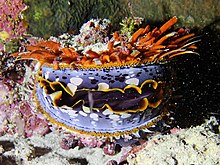| Pectinoidea | |
|---|---|

| |
| Spondylus varius | |
| Scientific classification | |
| Domain: | Eukaryota |
| Kingdom: | Animalia |
| Phylum: | Mollusca |
| Class: | Bivalvia |
| Order: | Pectinida |
| Superfamily: | Pectinoidea Wilkes, 1810 |
| Families | |
|
See text. | |
| Synonyms[1] | |
|
Pectinacea | |
The Pectinoidea are a superfamily of marine bivalve molluscs, including the scallops and spiny oysters.[1]
Shell anatomy
[edit]All members of this superfamily have a triangular resilium with a nonmineralized medial core that functions below the hinge line.[2]
Families
[edit]According to the World Register of Marine Species, the Pectinoidea include these families:
- Cyclochlamydidae
- Entoliidae
- Neitheidae †
- Pectinidae (scallops)
- Pleuronectitidae †
- Propeamussiidae some are known as glass scallops
- Spondylidae thorny oysters
- Tosapectinidae †
- Families brought into synonymy
- Propeamussidae: synonym of Propeamussiidae
- Syncyclonematidae: synonym of Entoliidae
References
[edit]- Raines, B. K. & Poppe, G. T. (2006): "The Family Pectinidae". In: Poppe, G. T. & Groh, K.: A Conchological Iconography. 402 pp., 320 color plts., ConchBooks, Hackenheim, ISBN 3-925919-78-3.
- Bieler R., Carter J.G. & Coan E.V. (2010). Classification of Bivalve families. pp. 113–133, in: Bouchet P. & Rocroi J.-P. (2010), Nomenclator of Bivalve Families. Malacologia 52(2): 1-184.
- Dijkstra H.H. & Maestrati P. (2012) Pectinoidea (Mollusca, Bivalvia, Propeamussiidae, Cyclochlamydidae n. fam., Entoliidae and Pectinidae) from the Vanuatu Archipelago. Zoosystema 34(2): 389-408. [29 June 2012]
- ^ a b Gofas, S. (2012). Pectinoidea. Accessed through: World Register of Marine Species at http://www.marinespecies.org/aphia.php?p=taxdetails&id=151320 on 2012-07-08
- ^ WALLER, THOMAS R. (2006). "Phylogeny of families in the Pectinoidea (Mollusca: Bivalvia): importance of the fossil record". Zoological Journal of the Linnean Society. 148 (3): 313–342. doi:10.1111/j.1096-3642.2006.00258.x.
Further reading
[edit]
Well, that’s interesting to know that Psilotum nudum are known as whisk ferns. Psilotum nudum is the commoner species of the two. While the P. flaccidum is a rare species and is found in the tropical islands. Both the species are usually epiphytic in habit and grow upon tree ferns. These species may also be terrestrial and grow in humus or in the crevices of the rocks.
View the detailed Guide of Psilotum nudum: Detailed Study Of Psilotum Nudum (Whisk Fern), Classification, Anatomy, Reproduction